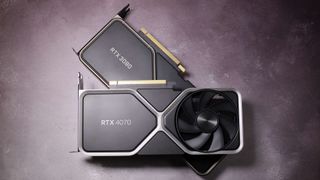AMD isn't alone in the Easter egg silicon doodle market, chipmakers have etched hamburgers, zombies, Smurfs, and even Groucho Marx onto their products in the past
Any chip with a Smurf on it is going to automatically be 10% faster.
Remember the story from last week about the image of a revolver and map of Texas, etched into one of the layers in AMD's old K7 chips? Not surprisingly, it isn't an isolated example of silicon shenanigans, as uncovered by a fan of chip easter eggs shows in an awesome compilation of processors, controllers, and memory die shots. Ducks, zombies, sharks, and dragons rub shoulders with the Playboy logo and a guitar-playing T-rex.
With fewer than 300 subscribers, YouTube channel CPU Duke is unfortunately not likely to appear in your recommended list, but it really should be (thanks to ComputerBase for the heads up). The main reason is the user's fantastic compilation of old chips being viewed under a microscope, highlighting the neat little easter eggs numerous designers added to the layout.
It's common practice for manufacturers to add a name or trademark and year to a chip, usually tucked away in a tiny blank section that's not used in any way. But give an engineer the opportunity to mark their work for prosperity and you'll get things like we saw with the AMD K7 CPU: an image of a revolver and a map of Texas, the home state of AMD.
But as you can see in the above video, chip designers are often wildly more creative than this. Cue a range of animals, monsters, buildings, and more besides. It has to be said that the quality of images varies a lot but some of these are on really old chips, where the process node technology was nowhere near as precise and near-flawless as it is today.

Best CPU for gaming: The top chips from Intel and AMD.
Best gaming motherboard: The right boards.
Best graphics card: Your perfect pixel-pusher awaits.
Best SSD for gaming: Get into the game ahead of the rest.
You might be wondering if there's anything like this on the latest processors from AMD, Intel, Nvidia, et al but I suspect not. The reason for this is the amount of free die space is incredibly small, as today's chips are designed to minimise the amount of wasted silicon as much as possible.
There could well be some hidden treats tucked away in a remote corner but it might be too small to easily detect in a normal microscope. Unless you've got something really powerful to handle and a couple of spare days in which to track across every micron of the die, the chances are that it may be missed for years.
I wonder if I can start a crowdsourced funding project to get my own electron microscope or maybe 'borrow' a couple of photomasks from AMD to see if it's still trying its hand at atomic-level art?
The biggest gaming news, reviews and hardware deals
Keep up to date with the most important stories and the best deals, as picked by the PC Gamer team.

Nick, gaming, and computers all first met in 1981, with the love affair starting on a Sinclair ZX81 in kit form and a book on ZX Basic. He ended up becoming a physics and IT teacher, but by the late 1990s decided it was time to cut his teeth writing for a long defunct UK tech site. He went on to do the same at Madonion, helping to write the help files for 3DMark and PCMark. After a short stint working at Beyond3D.com, Nick joined Futuremark (MadOnion rebranded) full-time, as editor-in-chief for its gaming and hardware section, YouGamers. After the site shutdown, he became an engineering and computing lecturer for many years, but missed the writing bug. Cue four years at TechSpot.com and over 100 long articles on anything and everything. He freely admits to being far too obsessed with GPUs and open world grindy RPGs, but who isn't these days?
Most Popular






